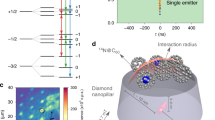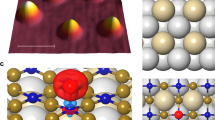Abstract
The manipulation of single magnetic molecules may enable new strategies for high-density information storage and quantum-state control. However, progress in these areas depends on developing techniques for addressing individual molecules and controlling their spin. Here, we report success in making electrical contact to individual magnetic N@C60 molecules and measuring spin excitations in their electron tunnelling spectra. We verify that the molecules remain magnetic by observing a transition as a function of magnetic field that changes the spin quantum number and also the existence of non-equilibrium tunnelling originating from low-energy excited states. From the tunnelling spectra, we identify the charge and spin states of the molecule. The measured spectra can be reproduced theoretically by accounting for the exchange interaction between the nitrogen spin and electron(s) on the C60 cage.
This is a preview of subscription content, access via your institution
Access options
Subscribe to this journal
Receive 12 print issues and online access
$259.00 per year
only $21.58 per issue
Buy this article
- Purchase on Springer Link
- Instant access to full article PDF
Prices may be subject to local taxes which are calculated during checkout




Similar content being viewed by others
References
Gatteschi, D. & Sessoli, R. Quantum tunneling of magnetization and related phenomena in molecular materials. Angew. Chem. Int. Ed. 42, 268–297 (2003).
Bogani, L. & Wernsdorfer, W. Molecular spintronics using single-molecule magnets. Nature Mater. 7, 179–186 (2008).
Leuenberger, M. N. & Loss, D. Quantum computing in molecular magnets. Nature 410, 789–793 (2001).
Park, H. et al. Nanomechanical oscillations in a single-C60 transistor. Nature 407, 57–60 (2000).
Park, J. et al. Coulomb blockade and the Kondo effect in single-atom transistors. Nature 417, 722–725 (2002).
Liang, W. J., Shores, M. P., Bockrath, M., Long, J. R. & Park, H. Kondo resonance in a single-molecule transistor. Nature 417, 725–729 (2002).
Harneit, W. Fullerene-based electron-spin quantum computer. Phys. Rev. A 65, 032322 (2002).
Morton, J. J. L. et al. Bang-bang control of fullerene qubits using ultrafast phase gates. Nature Phys. 2, 40–43 (2006).
Joachim, C. & Gimzewski, J. K. An electromechanical amplifier using a single molecule. Chem. Phys. Lett. 265, 353–357 (1997).
Lu, X. H., Grobis, M., Khoo, K. H., Louie, S. G. & Crommie, M. F. Spatially mapping the spectral density of a single C60 molecule. Phys. Rev. Lett. 90, 096802 (2003).
Yu, L. H. & Natelson, D. The Kondo effect in C60 single-molecule transistors. Nano Lett. 4, 79–83 (2004).
Pasupathy, A. N. et al. The Kondo effect in the presence of ferromagnetism. Science 306, 86–89 (2004).
Champagne, A. R., Pasupathy, A. N. & Ralph, D. C. Mechanically-adjustable and electrically-gated single-molecule transistors. Nano Lett. 5, 305–308 (2005).
Roch, N., Florens, S., Bouchiat, V., Wernsdorfer, W. & Balestro, F. Quantum phase transition in single-molecule quantum dot. Nature 453, 633–637 (2008).
Waiblinger, M. et al. Thermal stability of the endohedral fullerenes N@C60, N@C70, and P@C60 . Phys. Rev. B 64, 159901(E) (2001).
Trouwborst, M. L., van der Molen, S. J. & van Wees, B. J. The role of Joule heating in the formation of nanogaps by electromigration. J. Appl. Phys. 99, 114316 (2006).
Taychatanapat, T., Bolotin, K. I., Kuemmeth, F. & Ralph, D. C. Imaging electromigration during the formation of break junctions. Nano Lett. 7, 652–656 (2007).
Heersche, H. B. et al. Electron transport through single Mn12 molecular magnets. Phys. Rev. Lett. 96, 206801 (2006).
Jo, M.-H. et al. Signatures of molecular magnetism in single-molecule transport spectroscopy. Nano Lett. 6, 2014–2020 (2006).
Elste, F. & Timm, C. Theory for transport through a single magnetic molecule: Endohedral N@C60 . Phys. Rev. B 71, 155403 (2005).
Pasupathy, A. N. et al. Vibration-assisted electron tunneling in C140 single-molecule transistors. Nano Lett. 5, 203–207 (2005).
Guéron, S., Deshmukh, M. M., Myers, E. B. & Ralph, D. C. Tunneling via individual electronic states in ferromagnetic nanoparticles. Phys. Rev. Lett. 83, 4148–4151 (1999).
Timm, C. Tunneling through magnetic molecules with arbitrary angle between easy axis and magnetic field. Phys. Rev. B 76, 014421 (2007).
Huertas-Hernando, D., Guinea, F. & Brataas, A. Spin–orbit coupling in curved graphene, fullerenes, nanotubes, and nanotube caps. Phys. Rev. B 74, 155426 (2006).
Green, W. H. et al. Electronic structures and geometries of C60 anions via density functional calculations. J. Phys. Chem. 100, 14892–14898 (1996).
Almeida Murphy, T. et al. Observation of atomlike nitrogen in nitrogen-implanted solid C60 . Phys. Rev. Lett. 77, 1075–1078 (1996).
Pietzak, B., Weidinger, A., Dinse, K.-P. & Hirsch, A. in Endofullerenes: A New Family of Carbon Clusters (eds Akasaka, T. & Nagase, S.) 13–65 (Kluwer, 2002).
Yang, S. H., Pettiette, C. L., Conceicao, J., Cheshnovsky, O. & Smalley, R. E. UPS of buckminsterfullerene and other large clusters of carbon. Chem. Phys. Lett. 139, 233–238 (1987).
Pederson, M. R. & Quong, A. A. Polarizabilities, charge states, and vibrational modes of isolated fullerene molecules. Phys. Rev. B 46, 13584–13591 (1992).
Yannouleas, C. & Landman, U. Stabilized-jellium description of neutral and multiply charged fullerenes Cx±60 . Chem. Phys. Lett. 217, 175–185 (1994).
Modesti, S., Cerasari, S. & Rudolf, P. Determination of charge states of C60 adsorbed on metal surfaces. Phys. Rev. Lett. 71, 2469–2472 (1993).
Swami, N., He, H. & Koel, B. E. Polymerization and decomposition of C60 on Pt(111) surfaces. Phys. Rev. B 59, 8283–8291 (1999).
Udvardi, L. in Electronic Properties of Novel Materials—Molecular Nanostructures (eds Kuzmany, H., Fink, J., Mehring, M. & Roth, S.) 187–190 (AIP, 2000).
Deshmukh, M. M. et al. Magnetic anisotropy variations and nonequilibrium tunneling in a cobalt nanoparticle. Phys. Rev. Lett. 87, 226801 (2001).
Fujisawa, T., Austing, D. G., Tokura, Y., Hirayama, Y. & Tarucha, S. Nonequilibrium transport through a vertical quantum dot in the absence of spin-flip energy relaxation. Phys. Rev. Lett. 88, 236802 (2002).
Harneit, W. et al. Room temperature electrical detection of spin coherence in C60 . Phys. Rev. Lett. 98, 216601 (2007).
Jakes, P., Dinse, K.-P., Meyer, C., Harneit, W. & Weidinger, A. Purification and optical spectroscopy of N@C60 . Phys. Chem. Chem. Phys. 5, 4080–4083 (2003).
Koch, J., von Oppen, F., Oreg, Y. & Sela, E. Thermopower of single-molecule devices. Phys. Rev. B 70, 195107 (2004).
Acknowledgements
We thank R. Döring and O. Bäßler for their work to synthesize and purify the N@C60 and G. R. Hutchison for help with calculations. The research at Cornell was supported by the US NSF (DMR-0520404, DMR-0605742, EEC-0646547, CHE-0403806 and through use of the Cornell Nanofabrication Facility/NNIN). Work in Berlin was supported by the Bundesministerium für Bildung und Forschung under contract no. 03N8709.
Author information
Authors and Affiliations
Contributions
J.E.G. had the primary role in fabricating the samples, carrying out the measurements and analysing the data, with assistance from E.S.T. and J.J.P. and advice from D.C.R. C.T. carried out the model calculations. M.S. and W.H. led the molecular synthesis, purification and characterization. B.U. and H.D.A. carried out electrochemical characterization. All of the authors contributed to the data analysis and the preparation of the manuscript.
Corresponding author
Rights and permissions
About this article
Cite this article
Grose, J., Tam, E., Timm, C. et al. Tunnelling spectra of individual magnetic endofullerene molecules. Nature Mater 7, 884–889 (2008). https://doi.org/10.1038/nmat2300
Received:
Accepted:
Published:
Issue Date:
DOI: https://doi.org/10.1038/nmat2300
This article is cited by
-
Controllable Spin Switching in a Single-Molecule Magnetic Tunneling Junction
Nanoscale Research Letters (2021)
-
Readout and control of an endofullerene electronic spin
Nature Communications (2020)
-
Negative differential conductance and super-Poissonian shot noise in single-molecule magnet junctions
Scientific Reports (2015)
-
Thermal induced single grain boundary break junction for suspended nanogap electrodes
Science China Materials (2015)
-
The exchange coupling between the valence electrons of the fullerene cage and the electrons of the N atoms in \(\hbox {N}@\hbox {C}_{60}^{-1,3}\) N @ C 60 - 1 , 3
Theoretical Chemistry Accounts (2015)



